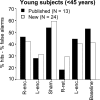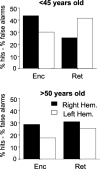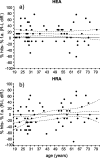Age-related functional changes of prefrontal cortex in long-term memory: a repetitive transcranial magnetic stimulation study
- PMID: 15356207
- PMCID: PMC6729939
- DOI: 10.1523/JNEUROSCI.0703-04.2004
Age-related functional changes of prefrontal cortex in long-term memory: a repetitive transcranial magnetic stimulation study
Abstract
Neuroimaging findings suggest that the lateralization of prefrontal cortex activation associated with episodic memory performance is reduced by aging. It is still a matter of debate whether this loss of asymmetry during encoding and retrieval reflects compensatory mechanisms or de-differentiation processes. We addressed this issue by the transient interference produced by repetitive transcranial magnetic stimulation (rTMS), which directly assesses causal relationships between performance and stimulated regions. We compared the effects of rTMS (a rapid-rate train occurring simultaneously to the presentation of memoranda) applied to the left or right dorsolateral prefrontal cortex (DLPFC) on visuospatial recognition memory in 66 healthy subjects divided in two classes of age (<45 and >50 years). In young subjects, rTMS of the right DLPFC interfered with retrieval more than left DLPFC stimulation. The asymmetry of the effect progressively vanished with aging, as indicated by bilateral interference effects on recognition performance. Conversely, the predominance of left DLPFC effect during encoding was not abolished in elders, thus probing its causal role for encoding along the life span. Findings confirm that the neural correlates of retrieval modify along aging, suggesting that the bilateral engagement of the DLPFC has a compensatory role on the elders' episodic memory performance.
Figures



Similar articles
-
Prefrontal and parietal cortex in human episodic memory: an interference study by repetitive transcranial magnetic stimulation.Eur J Neurosci. 2006 Feb;23(3):793-800. doi: 10.1111/j.1460-9568.2006.04600.x. Eur J Neurosci. 2006. PMID: 16487159
-
Low-Frequency Repetitive Transcranial Magnetic Stimulation of the Right Dorsolateral Prefrontal Cortex Enhances Recognition Memory in Alzheimer's Disease.J Alzheimers Dis. 2019;72(2):613-622. doi: 10.3233/JAD-190888. J Alzheimers Dis. 2019. PMID: 31609693
-
Unilateral repetitive transcranial magnetic stimulation differentially affects younger and older adults completing a verbal working memory task.J Neurol Sci. 2018 Jan 15;384:15-20. doi: 10.1016/j.jns.2017.10.021. Epub 2017 Oct 20. J Neurol Sci. 2018. PMID: 29249371
-
The role of the dorsolateral prefrontal cortex in retrieval from long-term memory depends on strategies: a repetitive transcranial magnetic stimulation study.Neuroscience. 2010 Mar 17;166(2):501-7. doi: 10.1016/j.neuroscience.2009.12.037. Epub 2009 Dec 24. Neuroscience. 2010. PMID: 20034547
-
Causal evidence supporting functional dissociation of verbal and spatial working memory in the human dorsolateral prefrontal cortex.Eur J Neurosci. 2014 Jun;39(11):1973-81. doi: 10.1111/ejn.12584. Epub 2014 Apr 9. Eur J Neurosci. 2014. PMID: 24713032 Free PMC article.
Cited by
-
A profile of brain reserve in adults at genetic risk of Alzheimer's disease.Alzheimers Dement (Amst). 2021 Jun 9;13(1):e12208. doi: 10.1002/dad2.12208. eCollection 2021. Alzheimers Dement (Amst). 2021. PMID: 34136636 Free PMC article.
-
Neuroplasticity and cognitive aging: the scaffolding theory of aging and cognition.Restor Neurol Neurosci. 2009;27(5):391-403. doi: 10.3233/RNN-2009-0493. Restor Neurol Neurosci. 2009. PMID: 19847066 Free PMC article. Review.
-
Investigating the effects of healthy cognitive aging on brain functional connectivity using 4.7 T resting-state functional magnetic resonance imaging.Brain Struct Funct. 2021 May;226(4):1067-1098. doi: 10.1007/s00429-021-02226-7. Epub 2021 Feb 18. Brain Struct Funct. 2021. PMID: 33604746 Review.
-
Reassessing the HAROLD model: is the hemispheric asymmetry reduction in older adults a special case of compensatory-related utilisation of neural circuits?Exp Brain Res. 2013 Feb;224(3):393-410. doi: 10.1007/s00221-012-3319-x. Epub 2012 Nov 18. Exp Brain Res. 2013. PMID: 23178904
-
Age-related changes to the neural correlates of working memory which emerge after midlife.Front Aging Neurosci. 2014 Apr 16;6:70. doi: 10.3389/fnagi.2014.00070. eCollection 2014. Front Aging Neurosci. 2014. PMID: 24795625 Free PMC article.
References
-
- Alexander MP, Stuss DT, Fansabedian N (2003) California Verbal Learning Test: performance by patients with focal frontal and non-frontal lesions. Brain 126: 1493-1503. - PubMed
-
- Babiloni C, Babiloni F, Carducci F, Cincotti F, Del Percio C, De Pino G, Maestrini S, Priori A, Tisei P, Zanetti O, Rossini PM (2000) Movement-related electroencephalographic reactivity in Alzheimer disease. NeuroImage 12: 139-146. - PubMed
-
- Brewer JB, Zhao Z, Desmond JE, Glover GH, Gabrieli JD (1998) Making memories: brain activity that predicts how well visual experience will be remembered. Science 281: 1185-1187. - PubMed
-
- Buckner RL, Wheeler ME (2001) The cognitive neuroscience of remembering. Nat Neurosci Rev 2: 624-634. - PubMed
-
- Buckner RL, Kelley WM, Petersen SE (1999) Frontal cortex contributes to human memory formation. Nat Neurosci 2: 311-314. - PubMed
Publication types
MeSH terms
Grants and funding
LinkOut - more resources
Full Text Sources
Other Literature Sources
Medical
